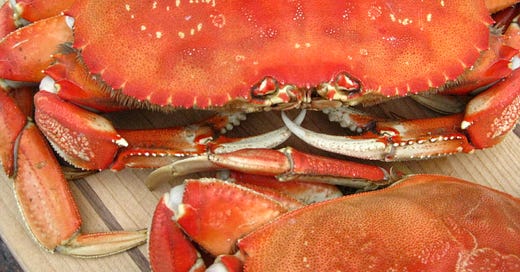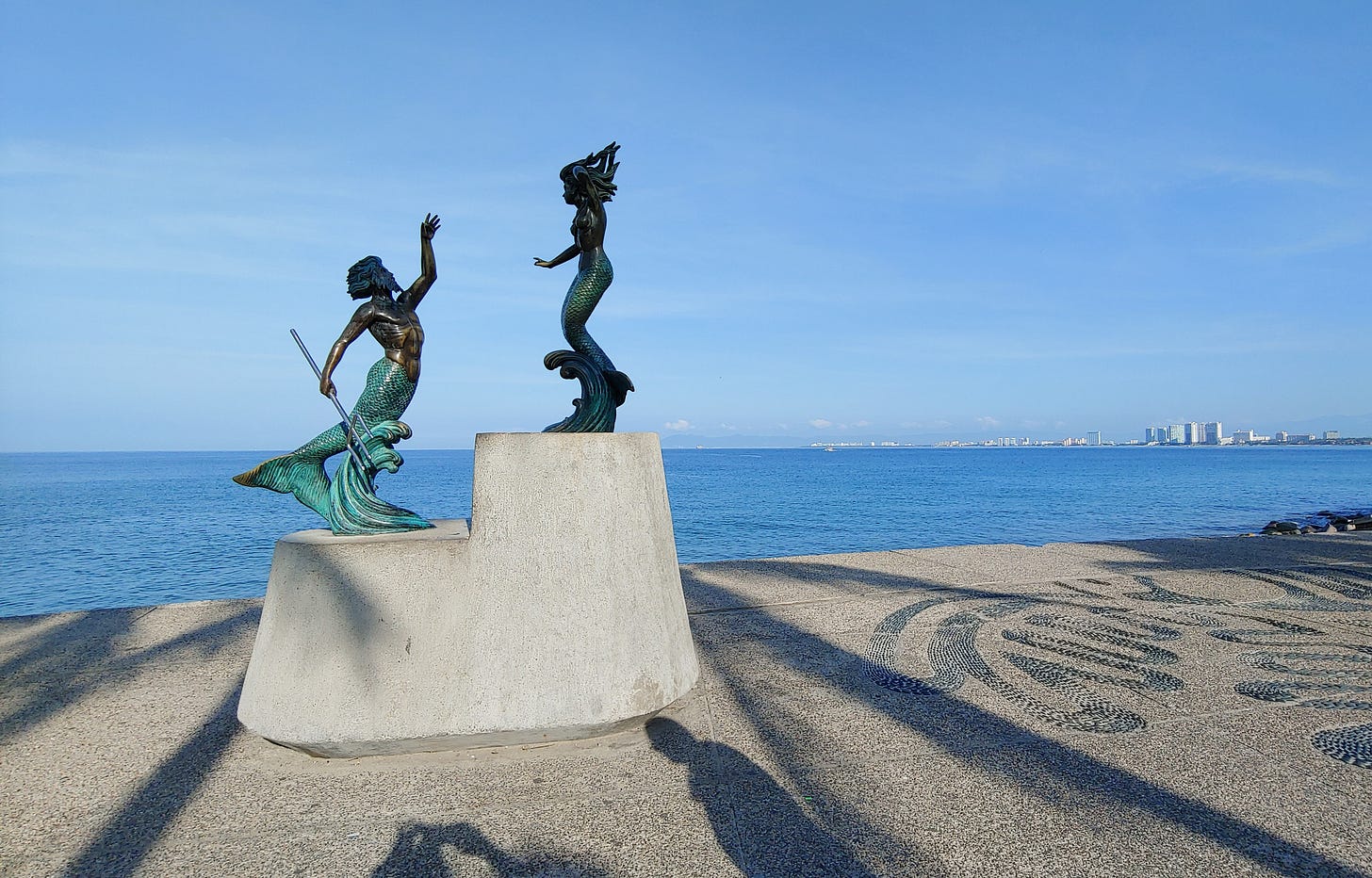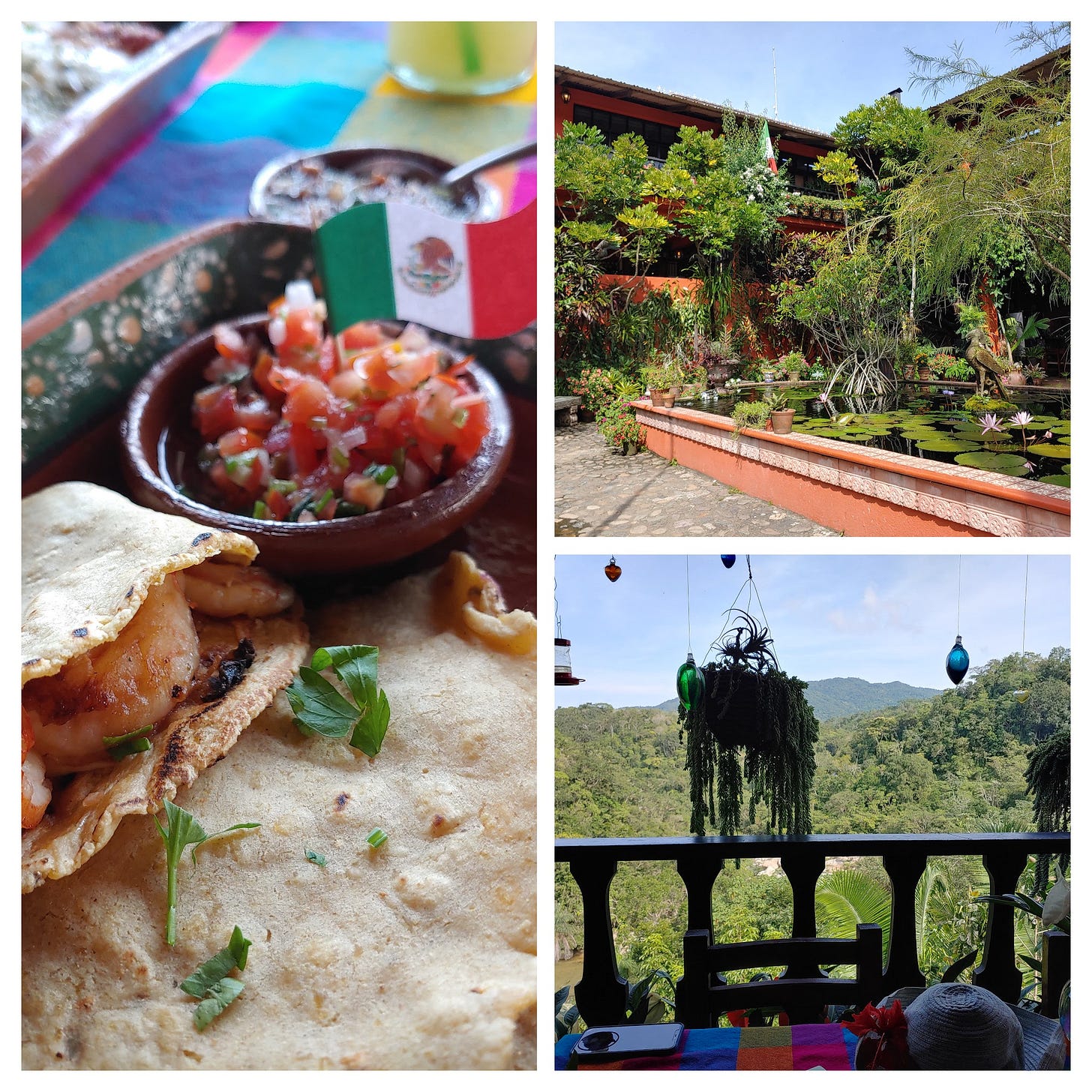I got home a few days ago from visiting dear friends who live in Puerto Vallarta. It was rough when they moved away from just a couple blocks down the street. Occasional video calls and texts are fine but don’t make up for time together. No online shared game could come close to the joy of sitting across from an old pal playing IRL cribbage—especially when I get to skunk him, but even when I get skunked in return. And nothing replaces the simple pleasure of being in the kitchen together or sitting around the dinner table.
I’m struggling to come up with a better word than ‘simple’ to describe the pleasures I hope to express this week. It’s about momentarily stripping away excess stimulation, avoiding the trends and novelty and attention-demanding influences that can suck up so much energy in our daily lives. The new viral recipe to try, the latest online game to play (count me among the Wordle-obsessed), the ingredient everyone’s suddenly flipping over (I was late to chili crisp, now on board, but behind on what’s come since). The constant tie to our digital devices. I played solitaire with an actual deck of cards for an hour, in the quiet, glancing up to look at the ocean now and then—it’s the most relaxed I recall feeling in ages.
Simple can sometimes suggest uninspired, bland, basic. But I extol here the most positive attributes of simple: unfussy, fundamental, uncomplicated, effortless. For me, such pleasures include unplugged time with friends and family, cooking too much food for said friends and family, a good long walk, just-cooked Dungeness crab, M*A*S*H reruns, an icy-cold martini, sunsets, the perfectly-proportioned BLT. Among many others.
While I was at a book signing a couple decades ago with a crab cookbook that just came out, a gentleman walking by glanced down at the book, looked up at me and said something along the lines of “who needs a cookbook for crab? all you have to do is steam it and eat it!” I think I just nodded and watched him walk away, because he was absolutely right. The simplest of preparations allow seafood to shine, allow us to taste their purest delights. Grilled whole fish, crumb-coated pan-fried oysters, shrimp sauteed in butter, scallops seared, mussels and clams steamed. The list goes on.
There are plenty of embellishments and variations we can turn to for delicious variety when cooking seafood. And I’m thankful for that, since I rely on all those varied options to fill cookbooks, which would be rather thin otherwise. Other times all we need is a vessel and some heat, maybe a bit of butter and lemon, perhaps none of that and only a shucking knife—the simplest of pleasures can be the most exquisite with seafood.
On the Road: Puerto Vallarta
As I said to a friend about another upcoming vacation trip, while I may not be in ‘work’ mode for all my travels—no notepad at the ready, no scheduled appointments to explore regional seafood offerings—I pretty much always have my seafood radar out wherever I go. Out of professional curiosity, sure, but even more for the sheer delights of trying whatever’s of note in that area. One of the best examples in recent years is recounted in this post following a vacation with friends near Charleston. The shrimp-centric meal we enjoyed there is among my most treasured travel memories.
The trip last week to Puerto Vallarta was all about reconnecting with friends: time with them was the top priority. That they happen to live in a beautiful coastal town with so much delicious seafood at hand is a lucky bonus. Though knowing them, I doubt they’d settle down somewhere that wasn’t within close proximity of outstanding seafood. Half of the duo, Scott, was the staff photographer at Simply Seafood magazine where I worked in the 1990s. It’s where we met, and we wasted little time becoming great friends. We’ve had loads of amazing seafood (and other food, we are omnivores after all) experiences together over the years, from a most memorable excursion to the Yukon River up in Alaska, to countless outstanding meals around our respective dinner tables. Getting a taste of the new home he and Elizabeth have in Puerto Vallarta was just the latest in those delicious adventures.
It was not a jam-packed few days racing around town to take everything in. I know I’ll be back. This visit included a morning stroll along the Malecón (the walking path along the bay), getting provisions at a couple markets (one open-air in town, the other a huge fancy place further out), and a drive out to the Jardín Botánico de Vallarta. What a treat to not only stroll through the beautiful gardens, but the drive there, much of it along the coast, was wonderful too. If you go to those botanical gardens, I highly recommend planning time for lunch too, it’s where we stopped first. What a great meal—flavorful shrimp quesadillas, for me—with gorgeous view and regular visits from the hummingbirds.
We had one “fancy” meal on my last night down there. Everything about our dinner at Trio was wonderful, an elegant meal with polished service, complete with cocktails and quite good Mexican rosé to accompany dinner. My Spanish is limited, so I was pleased to recognize the word huachinango on the menu, quickly chose that for my main dish—the red snapper served over ratatouille, with lime-cilantro salsa. Divine.
I also loved the dinner a couple nights earlier, a neighborhood spot on a corner just north of the very busy park in which a hundred activities seemed to be happening every time we went by. Different in character, yes, but perfect in its way, great service, very good guacamole (which I can never get enough of), a delicious piece of mahimahi simply cooked and absolutely satisfying. Oh, and the perfect shot of warming tequila with lime as the complimentary finale.
In the Kitchen: Storing Shellfish
On a survey about seafood shopping that I put together recently (if you haven’t filled it out yet, I’d appreciate getting your input, a link is in this post), among questions I asked was what seafoods folks aren’t currently comfortable cooking but might if they learned more about how to choose, store and/or prepare it. By far the greatest number of responses were shellfish, clams and mussels in particular were mentioned the most.
I can understand the apprehensions. Clams, mussels, and oysters in the shell certainly take more care in choosing and handling than does a piece of fish fillet. These shellfish are alive when purchased and need to stay that way up until the time they’re cooked. I will go into more detail over the months about the particulars of choosing and handling the different types of bivalves.
For today I want to focus on what to do with those live in-shell bivalves once you get home from the store. It’s important to get them out of their packaging and stored in the fridge in a way that provides them air while also keeping them moist. Here’s a video I posted on Instagram not long ago, with oysters as the example.
This particular option works best with smaller batches of shellfish that will fit in a standard colander and large bowl. When I have large volumes of shellfish to store—as when a box is delivered with a couple 5-pound mesh bags—I clear out a produce bin in the fridge, line it with a large plastic bag to catch drips and put the bag(s) in there. I’ll top the shellfish with a damp towel as for the colander, and be sure to keep the top open for air circulation.
It's always great to cook seafood relatively soon after you purchase it, but don’t feel that you need to scurry and fuss to cook these live shellfish within hours of buying them. Good quality shellfish well stored should be good for a couple of days. When you’re later rinsing (and debearding, if needed, in the case of mussels) the shellfish just before cooking, it’ll be important to confirm that they’re still alive. The shells should be firmly closed, or if any gape a bit, they should firmly close when tapped on the counter. Any that don’t close should be discarded before cooking, along with any that have broken shells.
Recipe Box: Steamed Clams
Steaming clams makes for a pretty fabulous example of a classic starting point that the cook can embellish countless ways. Based on the seasons, what’s in your fridge, who’s coming over, what you have a hankering for, or whatever inspiration is at hand, you can easily adapt with a range of ingredients. (I’ll get more into different clam varieties another time. As a West Coaster I am most always cooking Manila clams, on the East Coast small littleneck clams work here. The “steamer clam” of New England is less familiar to me and different enough to not easily swap for other clams. At least to my understanding.)
For this informal recipe, you could start with a few pounds of well-rinsed clams, which can serve 2 to 4 pending what role in the meal and appetites of those dining with you. A medium pot of roughly 5- to 6-quart capacity is ideal for steaming. Add some liquid to the pot, which could be water, dry white wine, beer or hard cider. How much? It can be as little as 1/4 cup if you don’t care about having much liquid to serve with the clams. Once a little steam gets going and a few clams open, they contribute more liquid to the pot and you’ll still end up with flavorful cooking liquids when done. If you want plenty of liquid in which to plunge crusty bread, use 1/2 to 3/4 cup.
For aromatics and seasonings, there’s a world of possibilities. Thinly sliced onion (yellow, shallot, green onion or leek), chopped garlic and herbs (parsley, basil, thyme, tarragon, shiso, whatever you love) are a classic combination. You could add chopped bell peppers, celery, tomatoes, fennel bulb, and/or ginger. Or how about kimchi, curry paste, hot chile peppers? Follow whims, though opt for items that will be fine with brief cooking. (An option is to saute ingredients such as onion, fennel, peppers in some butter or oil for a few minutes to soften, before adding clams and liquid to the pot.) How much depends on intensity of flavor and what you’re going for—diced tomatoes as a light accent (+/- 1/2 cup) or more substantial component (a couple cups), for instance.
With the clams (and liquid with whatever few embellishments) in the pot, add the lid, set it on medium-high heat, and cook for a few minutes. Stir the clams around a bit, return the lid and continue cooking until all (or at least most) of the clams have opened, a few minutes longer. Scoop everything into shallow serving bowls, though leave behind in the pot any clams that have not opened. You can cook those clams for an extra minute or two until opened, but discard any clams not opened after that time.
Oh, and don’t forget the bread that’s de rigeur for serving alongside, to be sure every drop of the briny juices get sopped up.

Out and About: Shellfish Signing
Seattle-area folks, I will be signing copies of Shellfish at the Urban Craft Uprising “Gobble Up” event held at Magnuson Park on Saturday, November 19 from 1:00 to 2:00. It’s a free event, with a wide range of food and beverage vendors on tap. And seafood lovers take note: among the food trucks due to be on site is one featuring delicious Alaska weathervane scallops. Mmmmm, can’t wait to get my share of those delicious scallops. More details about the event here, including a link to get free tickets.











